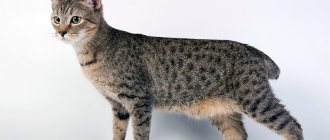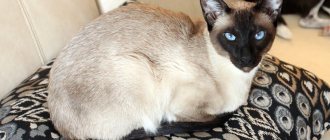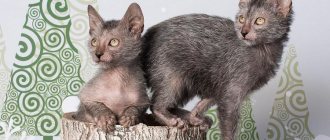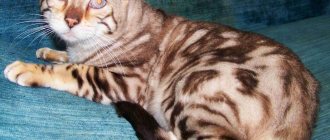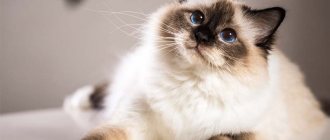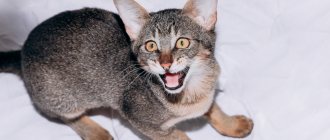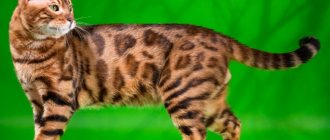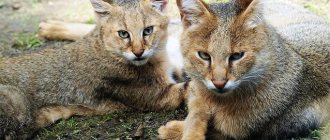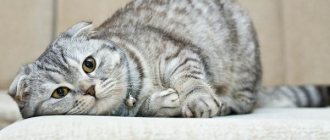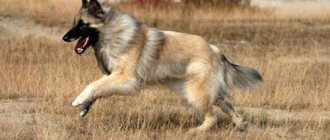A cat is like a leopard, it is also a Bengal or Asian - smart, curious and very active. He is constantly on the move, loves to climb higher, plays a lot and easily learns to walk on a leash.
What makes cats absolutely happy is access to free range and the opportunity to exercise their hunting instinct. Bengals are able to catch fish if there is an aquarium in the house. They won’t refuse to take a shower or swim in the bath. By nature, kitties crave constant attention, therefore, if there is a person in the family who often stays at home, then the pet will enjoy the company of the owner.
Attachment to family
Asian leopard cats are extremely socialized creatures: •accompany their owners within the apartment; •they enjoy walking on a harness; •suffer when left alone. Sometimes they adapt - they sleep during the day, and play and communicate with family members in the morning and evening. Without attention, care and attention can withdraw - they can begin to hide under furniture and use the cushioned spaces as a toilet. Another option is to keep themselves busy by playing with household items and damaging things.
Breeders advise getting a pair of Bengals if they have to do without human company for a long time. Then the animals do not leave their state of comfort and do not destroy household items.
A cat is like a leopard breed, only outwardly similar to a wild animal. Hybrids have 15–20% wild genes, which determine only behavioral characteristics - a love of water, climbing and hunting-style games. Affection and attention to the new pet will provide a friendly companion, affectionately attached to family members.
Bengal cat. Huntress.
Exceptions are cases when the kitten is left to its own devices, is not accustomed to being handled, or is being punished. Such an animal will begin to experience not attachment to the family, but fear and depression and will be useless as a producer. Breeders testify that psychological trauma can only be corrected in young animals no older than 1–1.5 years.
History of the discovery of the ALA species
In 1958, Russian scientist Nikolai Severtsov made the first classification of wild cats of Southeast Asia, and in 1917, English zoologist Reginald Pocock confirmed and developed this classification. They divided the Asian or Oriental cats (Prionailurus) into 4 species, one of which was the Asian leopard or Bengal cat. In Latin it is called Prionailurus (Felis) bengalensis, after the name of the region of Bengal in India where Europeans first saw these animals. By the way, R. Kipling’s book “Mowgli” was written about those places. Now this territory - in the delta of the Ganges and Brahmaputra rivers - is divided between India (West Bengal) and Bangladesh (East Bengal). The region has retained its roots; it is inhabited by Bengalis who speak the Bengali language.
The Bengal cat is the most numerous wild cat in Asia.
The cat Prionailurus (Felis) bengalensis has many names: Chinese cat, Ellata cat, Javan cat, dwarf cat, Wagati cat, coin cat, Asian leopard, Far Eastern cat, etc.
The Chinese called this cat “coin” because the spots on its skin resembled the coins that were in circulation in Ancient China.
This number of names is due to the breadth of geographical distribution and the number of subspecies living in different parts of Asia: Indian, Himalayan, Chinese, Far Eastern and others. In total, there are about 20 varieties that differ in color shade and the shape and size of spots: cats living in warm regions with a humid climate have a brighter skin color (yellow-brown with black spots) than those living in the north (yellowish-gray tones with red - brownish spots). All Asian leopards have spots that are elongated horizontally.
Gaming potential
A leopard-like cat is always ready to play and at any age. Innate intelligence helps Bengals learn funny and sometimes catastrophic techniques: •understand and carry out commands such as fu, come to me, here; •trained - bring slippers, catch and return the ball; • study and repeat the actions of the owners, as a result they are able to open and close door latches, taps, and flush the toilet repeatedly. The play potential should be taken into account when leaving pets alone at home, because after opening the water, the cat will not necessarily want to close the tap.
Bengal cat in the bath
ALA habitat and role in the ecosystem
Asian leopard cats live in southern and eastern Asia, their range is very wide and diverse: Indonesia, Malaysia, India, Thailand, China, Taiwan, Laos, Cambodia, Korea, Pakistan and even the Russian Far East. This is surprising, but cats living in the tropical jungles of Indonesia or Thailand belong to the same species as our Far Eastern (Amur) cats.
Distributed in the Far East, in the Amur River basin and along the coast of the Sea of Japan
Leopard cats, like many other predators, play an important role in the ecosystem - they regulate the numbers of rodents, small mammals and birds, and destroy weakened and sick individuals. As the population of predators decreases, the number of their potential victims increases, which more actively destroy forest vegetation and harm human crops.
Care and feeding of Bengals
A short-haired cat brings less worries at home than its long-haired counterparts, which makes caring for your pet much easier. Keeping and caring for a cat is not difficult: 2-3 times a week, devote a little time to combing the fur, which a soft rubber brush will help with. Sometimes you may not even notice the shedding, but once the procedure has begun, it is better to comb the kitty more often.
The descendant of a wild leopard cat needs to trim its claws once every couple of weeks. The ears are cleaned at the same intervals with a damp cotton pad.
It is also necessary to take care of your pet's oral cavity by brushing its teeth once a week.
The bath easily becomes a favorite place for the Bengal, who happily hits the water with his paws. Washing is allowed in rare cases using special cat shampoos.
Feeding a Bengal kitten occurs from month to month according to the feeding schedule and recommendations of specialists. Good nutrition quickly turns a small cat into a healthy, strong cat.
What to feed a Bengal kitten for 2 months
They also feed raw meat (beef or rabbit), exclude raw offal from the diet, replacing them with boiled sea fish once a week. Dairy products in the form of kefir, baby cottage cheese without any additives, and low-fat cream are useful for cats. The daily food intake also involves the addition of vegetables not exceeding a quarter of the volume of meat products. These are carrots, tomatoes, bell peppers. A Bengal cat can be switched to premium and super premium dry food, which the animals eat with benefit and pleasure.
Keeping a neutered cat involves replacing natural nutrition with specialized food.
Serengeti
The Serengeti cat has the following characteristics: large ears, long legs, spotted body color and honey-colored fur around the eyes. Males are usually larger (up to 15 kg) with females weighing up to 12 kg. The behavior is more playful than with the habits of a hunter, curious, and the breed is also talkative.
The Serengeti can make a wide variety of sounds. They are characterized by dexterity and courage. For example, they attack dogs rather than hide from them. They also climb to any heights, fulfilling their curiosity, and are sociable on walks.
When breeding this breed (in America), the goal was to resemble the Serval. The Serengeti was obtained by crossing several breeds, including Bengal, Abyssinian and others. The experiment continues until now until an analogy of the serval without the admixture of its blood is derived.
Asherah
Another desirable leopard cat breed is the Ashera (mini leopard). It is considered the most expensive. The biotechnology company Lifestyle Pets bred her in 2006 as a result of an experiment with genes from an African serval, a wild leopard and a regular domestic cat.
The weight of the animal is up to 14 kg, the paws are powerful, and the animal has a grin. But as a pet, the Ashera is ideal; it has the usual cat habits.
Grooming is not difficult, the breed is unpretentious, and is not aggressive in nature. Loves delicious food, sleep and playing with the little inhabitants of the house. She walks outside with a leash. Its cost is significant, from $22,000, but it is very difficult to buy a copy.
People sign up for the waiting list a year in advance.
There are 4 types of Asherah:
- regular;
- snowy (with white color);
- hypoallergenic;
- royal, whose spotted color is orange on a caramel background, is the rarest.
The latter type of kittens are born no more than 4 per year and cost more than $125,000.
Nutrition
In terms of food, the forest cat is also a gourmet and a glutton: he prefers to eat fresh prey; his daily diet can consist of a dozen small rodents. An adult can consume up to a kilogram of food daily.
Top Articles: Natural Resources of North America
The victims of cats are:
- field mice
- Sony
- partridges
- pheasants
- coots
- gray rats
- muskrats
- trout
- nutria
- rabbits
- moles
- squirrels
- shrews
- caresses
- martens
- lizards
Once upon a time, cats living in the steppe regions caught bustards and even eagles; sometimes a large individual can defeat a small roe deer. Predators living on the banks of rivers and the inhabitants of floodplains hunt for fish and aquatic animals.
When approaching human habitation, cats free the surrounding area from the rodents that have settled there. While helping people in this way, they are doing harm at the same time by eating poultry. They cause harm to wildlife by destroying rare birds in protected areas (for example, in the Caucasus).
The meal process resembles that of an ordinary cat, but the front paws do not fall to the ground. It chews its prey, biting off one piece at a time, starting from the side of the carcass.
Buying kittens
Leopard cats are an extremely rare breed in Russia. Therefore, when buying such a pet at the market, in a pet store or through an advertisement, you can buy an ordinary yard cat that will only vaguely resemble a leopard.
Bengal kitten
If you have decided to buy just such a pet that meets all standards, then it is best to do this in a nursery or from a breeder registered in Russia.
What to look for when choosing a kitten
It is best to purchase a leopard-colored kitten when it is three months old. During this period, the child's pattern fades and changes to an adult one. The coloring is finally formed by the age of eight months. It is impossible to pick up a leopard breed baby before he reaches 2.5 months of age.
Note! When choosing a pet, you should carefully examine the baby and its coloring. It is better to give preference to the most curious and active kitten.
You should look at its spots and pattern. The kitten's mother should also be assessed. If this is not possible, then you can ask the seller for at least a photo. By the appearance of the mother, she will know what to expect from the baby in the future. The color of the mother's coat should be bright and the pattern clearly defined.
The best breeders and nurseries
Today in the Russian Federation there are about 150 organizations that are engaged in breeding leopard animals. The most common of them are the following nurseries:
- Wildbenjamin;
- Gelense Style;
- Bengalina Pride;
- Saeva Gratia;
- Shine Golden Irbis;
- Amaty Cay;
- New Generation;
- Volgabengal;
- Honey Sallada;
- Crimean Pride.
These are not all nurseries where you can buy leopard cats.
How much does a kitten cost approximately?
The cost of a kitten is determined by compliance with the standard and its pedigree. Depending on this, you can purchase kittens at a price of 7 to 15 thousand rubles. without pedigree. In nurseries, the cost varies from 15 to 30 thousand rubles. Adult individuals for breeding with excellent breeding qualities cost between 50 and 100 thousand rubles*
Picture 10. A purebred Bengal cat is quite expensive.
The leopard cat is an unusual and unique animal. The color of this pet resembles a leopard. Having adopted such a kitten into your family, you need to take care of providing it with proper upbringing and proper care. Only in this case can you raise a tame cat that will become a favorite and a full-fledged member of the family.
*Prices are as of September 2022.
Photo gallery: Asian leopard cats
The Far Eastern Asian cat is listed in the Red Book
ALC reacts to everything new and unusual with hissing
Asian leopards primarily hunt at dusk and at night, but can also do so during the day.
Far Eastern (Amur) cats live in our country in the taiga in the Far East
The Far Eastern Asian cat has a slightly different skin color, longer hair and close-set small eyes compared to the ALC from the southern regions
Small Asian leopards are just as cheerful and playful as regular cats.
When keeping ALC in enclosures, they try to create an environment close to natural for them - with ponds, trees and, of course, a shelter, heated in winter
Keeping an Asian leopard cat in a city apartment is possible only if the owner has a lot of free time, patience, effort and material costs, and above all, a strong desire to keep a predatory cat from the forest in his home. At the same time, a successful taming result cannot be guaranteed, because such a pet remains a predator whose behavior is based on instincts. It is more expedient to keep ALC in country houses by equipping special enclosures for them. Before purchasing a wild Bengal cat, it will be useful to inquire about the legislation in this area, because in some countries certain types of ALC are protected, and keeping them at home is punishable by law. There are no such prohibitions regarding hybrids of wild and ordinary cats, and the easiest option is to take a closer look at the domestic Bengal breed, whose representatives are no less beautiful than their wild ancestors, but at the same time are much more adequate in communicating with people.
Arabian Mau
It also has spots, and the coat itself has no undercoat. Color ranges from white with black spots to black without spots. The main color of the breed is brown or gray with patterns.
This cat cannot claim the title and is only temporarily recognized, but in 2008 it was standardized. For the Middle East, this animal is native. Characteristics: Large size, muscular, high legs, tapered tail. The paws are rounded, and large ears are located above the head. Males are larger than females, weighing up to 8 kg.
The Arabian Mau has oval eyes that match the color of its coat. Friendly character: accompanies owners, plays with children. Care - weekly brushing, ear cleaning, walks.
The breed standards are as follows:
- A muscular body with long legs cannot be called very slender.
- The coat is adjacent to the body, hard, and in adult specimens silkiness is excluded.
- The coloring is very diverse: black spots on a white background and white on black, tabby (pattern on the body), gray and brown tones.
External features
The Asian wild cat is one of nature's most unusual creatures. The thing is that the breed combines the pristine wild appearance of a leopard and the small forms of a domestic pet.
Color
The Asian leopard cat has short hair and a thick coat. The fur of such a cat is soft, it shines, glosses and shimmers beautifully in the sun. The color of the breed in almost all cases is clearly spotted, but will depend on the original habitat of the animal:
- For cats that live in the southern regions, the standard coat is yellow with dark spots on the coat. Such cats vaguely resemble in their color the wilder ancestor of cats - the puma. Also, a similar color characterizes the Asian golden cat subspecies.
Golden color is Temminka’s calling card (Asian golden cat in the photo)
- The Asian smoky cat is a species that is characteristic of the taiga and northern China. These cats have grayish fur, with light and brown spots scattered in strokes.
IMPORTANT: it is noteworthy that the ancient Chinese considered cats with this color to be “coin cats” - the shape of the spots on their fur resembled actual coins.
The Asian leopard cat species has common features: the same arrangement of stripes and spots, regardless of the region of residence, cream or white fur on the sternum and abdominal cavity. On the back, spots form in a line, and towards the end of the tail there are light rings. The tip of the tail of such a cat will always be black.
The fur of "Asians" is shiny and soft to the touch.
Size and weight
On average, an Asian cat weighs no more than 5-8 kg and reaches 47 cm in length. Parameters may vary depending on the place of residence:
- Indonesia: 5-7 kg, 45 cm.
- Far East: 9-16 kg, 60 cm.
- North China: 2-4 kg, 35 cm.
The body of wild miniature predators is slightly elongated, the legs are elongated and muscular: the front legs may be slightly shorter than the hind legs. It is this feature that allows predators to deftly climb trees and climb branches; in a race they can not get tired for a long time and successfully drive in prey. Thanks to their webbed feet, Asian cats are very good swimmers.
Eye color
The eyes of an Asian woman are a separate world. These are large, deep, bright yellow eyes with an amber tint. Sometimes the eye color can be light blue or blue.
Some individuals have blue eyes
Ears, tail
The Asian leopard cat's tail can be as long as half the length of its body. The tip of the tail is always black, the tail itself is pubescent and covered with numerous spots and stripes. The tail length is 15-20 cm, in some cats that live in the taiga it is up to 45 cm.
The muzzle of such cats is short, slightly narrowed, and the ears are rounded. There is a white spot in the center of the outside of the ears.
Price
The cost of a Bengal kitten can start from fifty thousand rubles and end at around one hundred and fifty.
Even if you want to save money, you should not look for private advertisements on the Internet. In this case, you buy a cat with your eyes closed and risk your money. It is better to contact professional nurseries with a request to contact you if they have a cub with a defect.
Any deviations from the standards or even a slight birth injury are possible, in which case you can buy a small leopard at a big discount
Please ensure that all vaccinations are up to date. You will be able to pick up your baby only when he reaches three months.
Parasitic bees
Among bees there are entire subfamilies of kleptoparasites - insects that appropriate other people's nests and food. In other words, they live off the labor of other bees. They are called cuckoo bees due to their similar behavior to birds of the same name.
Neon cuckoo bee
In such species, the body is not sufficiently developed to collect pollen and nectar. They also do not build nests. Instead, insects throw their eggs into other people's homes. When a kleptoparasite larva appears, it can destroy other larvae and all food. Sometimes such bees destroy the queen of the colony, and themselves settle in the nest.
Diseases
Bengal cats are naturally healthy creatures, and a couple of years ago, only intestinal disorders and a weak stomach were mentioned among the problems of these animals. However, these pathologies did not affect the pet’s lifespan in any way.
However, recently, owners have often received information about other diseases of Bengals, which are often diagnosed in kittens - flat chest syndrome and hypertrophic cardiomyopathy. In the first case, the sternum puts too much pressure on the heart and lungs, causing breathing problems in the kitten, and in the second, one heart wall is thicker than the other. Both ailments most often lead to the sudden death of a pet.
Veterinarians include the formation of cysts on the kidneys and even blood cancer as hereditary diseases. To avoid difficult situations, it is better for breeders not to experiment with nutrition and not to feed their cats food from the common table - what is well absorbed by the human body can be dangerous for a cat.
You should not mix natural nutrition and the use of feed - the fact is that dry and wet foods are digested differently by the organs of the digestive system, so mixed feeding will lead to serious gastrointestinal pathologies. If for one reason or another you are forced to switch your Bengal from one food to another, then you need to do this gradually - usually it takes about a month for a complete replacement.
Some lines of Bengal cats cannot boast of good immunity. As a rule, this happens in cats whose ancestors were often crossed with close relatives.
Lifestyle
The Far Eastern leopard is a crepuscular animal. He goes hunting in the evening or at night. Rarely, but if very hungry, it can pursue prey during the daytime.
It most often attacks its prey from an ambush.
The predator approaches it very carefully, trying to use the local terrain to get closer. The leopard goes to drink only when it is dusk in the forest
The beast has very sharp vision. He can see his prey at a great distance (up to 1.5 km). But with hearing and smell the situation is somewhat worse.
The Far Eastern leopard is an excellent tree climber. Even large prey is easily dragged onto the branches.
At short distances it develops a very decent speed (55 km/h). This cat doesn't really like to swim.
Often uses roads and paths made by humans. He is not afraid of him, does not attack, but simply tries to leave unnoticed. It cannot stand the constant presence of a person - it leaves such places forever.
Lives in one area for many years, walks along the same paths and uses the same brood dens.
Cheeto is not the smallest pet cheetah
catbreedswithpictures.com
The breed is only 15 years old and few have heard of it yet, although the actor who played Agent 007, Sean Connery, has already managed to acquire a funny kitten. Chitos are large cats, weighing up to 10 kg. They are very energetic and intelligent, easy to train, so they do not cause problems in keeping.
Chito is the result of crossing an Ocicat and an Abyssinian cat. They have a soft, creeping gait, characteristic of cheetahs and tigers, a calm character and obedience, rare for cats.
Breed nutrition
If everything is fine with the kittens, then they grow quickly and by 3-4 months they already begin to hunt on their own. They hunt in the zoo, of course, on mice and lemmings thrown into their cages by zookeepers, but they also like lean beef.
The concentrated food from bags and cans familiar to our cats is strictly prohibited! And this is also another problem when raising young Pallas’ cats.
And, of course, the problem is their behavior! Pallas' cat kittens, by the age of hunting, grow very long, awl-shaped teeth, which with age will be replaced, of course, by wider and not so long permanent teeth, but the character inherent in nature is preserved from the first days.
These babies bite very painfully, inflicting painful wounds on the hand that feeds them, as soon as the attendant “gazes” a little while feeding or tries to stroke the pussy.
Kanaani
The Kanaani cat (or Canaani) is a new breed bred by an Israeli resident D. Pollacek, registered in 2000. Several breeds were crossed: Bengal, Libyan steppe, Abyssinian, common domestic and others.
The mixture of Libyan and homemade turned out to be the most successful. The animal has an independent character, distinguished by its love of walks and freedom. But the cat also adapted well to the new environment, was unpretentious in care and undemanding in nutrition. Balanced habits and love for affection do not exclude the fact that she definitely needs a leash on the street, otherwise she will run away.
The Kanaani is a breed with a short, coarse coat that ranges in color from light yellow to brown with contrasting spots. At medium size, large specimens are found.
They are strong, have well-developed muscles, high legs, on which they run quickly. It is necessary to add almond-shaped eyes and tufts on the ears of some individuals. Health is good, you just need to find a common language with your pet in order to live in harmony with it.
Life of wild forest cats in nature
Forest cats have a wide distribution area and are found in Europe, Africa, along the shores of the Sea of Japan, in the jungles of India, the steppes of Turkestan, the mountains of Scotland and the Caucasus.
You can still find a lot of wild cats in the Scottish mountains
These animals prefer to settle in deep forests, where people rarely visit. Therefore, it is rare to discover the wild ancestors of domestic purrs. Mountain clefts and deserted shores of reservoirs become favorite places for forest cats to live.
These small predators can choose abandoned fox or badger holes, empty tree hollows, and even uninhabited nests of large wading birds as shelter.
The territory occupied by one animal is about 2 hectares in size. Boundaries are marked with the help of odorous anal secretion, with which males carefully irrigate trees and shrubs. An irreconcilable war is waged for each plot, especially during the mating season.
It is also interesting that wild cats do not like areas where there is a lot of snow. After all, under the abundant snow cover, it is difficult for small animals to get food. Therefore, in especially snowy winters, purrs walking on their own can be found near a person’s home. This is how forest cats try to survive, because people always have food.
Peculiarities of behavior of forest cats
Since these representatives of the cat family are wild predators, the cats have a corresponding disposition. Animals love freedom and fiercely defend their independence.
Forest cats are skilled and dexterous hunters
Wild forest cats are loners, leading a secretive lifestyle. The animals quickly and easily evade pursuit, hiding in gorges or on treetops. They lead a nocturnal lifestyle, but do not shy away from hunting in the daytime.
Any small animal that can be caught can serve as prey for forest purrs. These can be rats, nutria, as well as hares or squirrels. A wild cat will not refuse to catch waterfowl, fish, and even crayfish. And in arid regions, insects, snakes and lizards become victims of tailed animals.
The method of attack of forest cats is similar to the hunting methods of other representatives of the species - predators catch prey in a jump, sometimes reaching a length of three to five meters.
To hear even a “word” from a wild forest hunter, you need to greatly anger the animal. And then the animal will make hissing, howling or even whistling sounds. And the meowing typical of cats can only be heard during mating dances and the search for a partner.
Procreation issues
For most of the year, wild forest cats prefer to avoid the company of even their own kind. However, with the onset of cold weather in January, males begin to gather in small groups and look for females for mating until the end of March.
Wild forest cats give birth to up to five kittens in one litter
If two cats develop a liking for the same cat, fights with characteristic fights and warlike cries arise between the furry “knights.”
It also happens that forest males choose domestic females as partners, and then the latter give birth to wild and wayward kittens.
Pregnancy in wild forest cats lasts 62–67 days, after which blind kittens are born. The eyes open only 9–12 days after birth. One litter usually produces five cubs, but there may also be one kitten. Or, on the contrary, the brood turns out to be numerous - up to seven heads.
Shortly before giving birth, the female finds a secluded place from which she makes a safe den. Kittens will grow up in this shelter until they are four months old. The mother cat feeds her cubs with breast milk for the same amount of time.
The level of safety decreases when the grown offspring begins to leave the den on their own - at one and a half to two months of age. And then martens and foxes will pose a threat to the life of the young animals.
At two months, young forest seals begin to go hunting, accompanied by a cat, and at five months they enter adulthood. Males begin to explore new lands, while females remain in the maternal area.
Forest purrs live for quite a long time - up to 15 years. However, young animals often die before reaching 10 years of age.
And if there are no threats in the form of large predators, then life expectancy increases up to 30 years of age. Such situations arise, among other things, when animals enter a person’s home.
